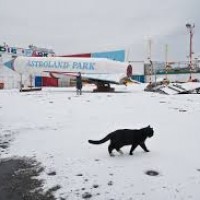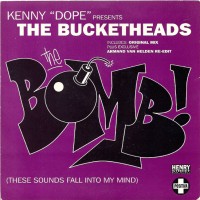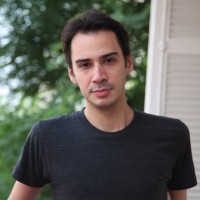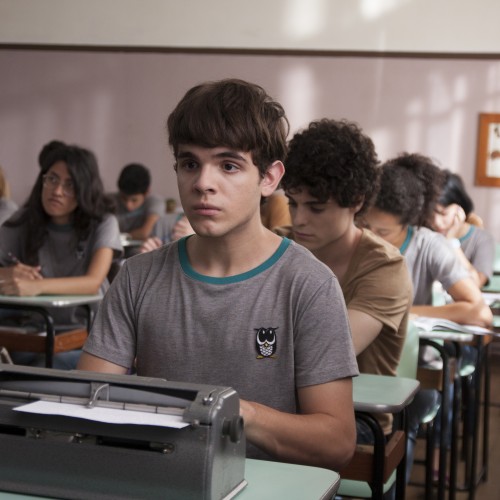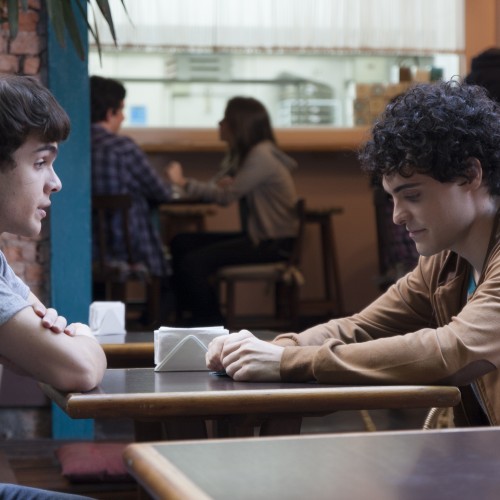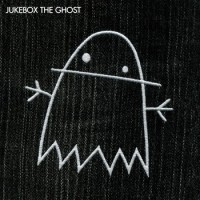- 9 years ago
-
Were you at this past weekend’s Brooklyn Electronic Music Festival? If not, you missed borough-load of great parties, soundtracked by scores of brilliant artists and DJs. One of the best was the Rinsed closing party, held in a Bushwick warehouse space and featuring guest sets from the inimitable Detroit producer Omar-S, the always-worth-catching Chrissy and the Basement Floor label’s Turtle Bugg. In case you’re not familiar with Rinsed, the soiree has featured iconic artists and DJs along the lines of Inner City, MK, MJ Cole, Juan Atkins and Todd Edwards; stars of slightly more recent vintage like Jackmaster, Jacques Greene, Ejeca, Ben Pearce and Chris Malinchak; local players like Juan MacLean, Justin Strauss, Morgan Geist, Populette and Aurora Halal; and a list of outliers that includes Actress, NGUZUNGUZU, Ital, Sepalcure and Jaw Jam. Oh, and a bunch of other people, too—not bad for a shindig that, when it debuted four years ago, hosted about a hundred people in the loft space above Public Assembly. Nowadays, resident spinners Dan Wender and Blacky II, along with Rinsed’s indispensable “visual aesthetician” A.Pop, are among those running the show in Kings County. We asked the core gang, Brooklynites all, what they loved about their home borough, and here are their wide-ranging replies.
A.Pop
Some things I love about BK:
That you can find cappuccino Lays chips in Bushwick, the best slice of your life in Midwood, 24-hour amazing tacos in Sunset Park, or blue ribbon/grass fed/farm-to-fork in Park Slope. Making fun of the people that refer to and debate about “farm-to-fork” in earnest.
Snow-covered Coney Island.
Any summer/spring/fall day in Fort Greene park.
The ability to be a totally “normal” human wandering around the new Times Square of Brooklyn (North 6th Street), and then chill in some weird storage unit turned temporary performance space/art gallery.
Hearing a beautiful opera or concert at BAM, and then blasting house and techno on one of the world’s best sound systems at Output.
Not spending my entire rent money at Output and catching Bossa Nova Social Club’s happy hour instead.
Not waking up the day after a night a Bossa.
That things like Trip House, Danger Boat, and Market Hotel were able to exist.
That one of my first memories of going out in Brooklyn was having to evacuate Studio B mid-Digitalism set because a fire broke out.
That things like the Waterfront Barge Museum exist.
That my friends range from architects, DJs, artists, producers, anthropologists, scientists, etc.
“Wing night” with said friends.
That we all at least secretively love those maps of BK neighborhood stereotypes, make fun of the other stereotypes that aren’t you, but know that in the end we are all the best and wouldn’t trade it for the world.
Blacky II
Proximity: Just about any musically related thing I ever want to do is less than a 10-minute bike ride from my apartment. If I want to pick up a new piece of gear or go to the club or buy a record or go to the studio, it’s all right here.
Variety: So many interesting musicians and artists to collaborate with and draw inspiration from. There’s so much diversity it never feels stale or monotonous. Even physically, you can do the polished-club things or the grimy-warehouse thing and everywhere in between,
Freedom: We’re lucky enough to live in an extremely accepting and nourishing community that embraces and supports difference. It’s really nice to see people expressing themselves without feeling they need to guard or filter their ideas. Shit has definitely been getting weird again, in the best way possible.
History: Brooklyn has such a musically rich history spanning all kinds of genres, but was especially integral in the early days of modern club music. Just take Kenny Dope for instance, The Bucketheads’ “The Bomb”!? Come on.
Community: I kind of touched on this in the freedom bit, but people are overall really supportive of what we’ve been doing the last few years, and it wouldn’t be possible without them. I don’t think most people realize how important and encouraging their support truly is.
Quality: we’ve got access to all the best stuff here, and an incredible hometown roster.
Anonymity: While there is a tightly knit community, Brooklyn is so big it’s relatively easy to disappear in the crowd (literally and figuratively) should you feel like it. People need to do that sometimes.
Spontaneity: There’s such an abundance of amazing people and events, you often find yourself hanging out at unexpected places with unexpected people experiencing new things you hadn’t planned on.
Motivation: There are a lot of talented people to compete with in Brooklyn, you really need to constantly be developing and sharpening your skills to set yourself apart.
Distraction: If you’re ever music-ed out, there are a million non-musical ways to unwind.
Dan Wender
While I’ll always have love for Manhattan, Brooklyn has become a drug and when I leave for too long I get withdrawals. I moved here from the city four years ago, and I’ve never looked back. There’s desperation, a hunger, everyone needs to get their project off the ground or they’re going to die. That’s really helped inspire me to work and sleep as little as possible. The stability of the Manhattan work-leisure model doesn’t harbor the creative pressure you feel in Brooklyn. It’s nice to go outside and see people wheatpasting Richard Simmons brain posters on the street and know they’re inspired and taking shit into their own hands.
Some of my favorite things:
Bay Ridge Halal Truck, 86th St and 5th Ave
Blacky and our buddy Nick showed me this place. It’s like 53rd and 6th but Nick claims it’s “more real”. He’s kind of right. If you happened to have a friend with a car and it’s five in the morning and you need all-out nourishment, this is the spot for those in the know. Expect a line.Here Comes the Sunz, rotates between Ft Greene Park, St Nicholas Park and Culyer Gore Park
I almost fear giving this one away but it’s probably the most incredible house-music experience that exists in Brooklyn, please use in moderation. A few Saturdays a summer (you can find out date and location by checking out their Facebook Page) Brooklyn Sunz take over select parks for an afternoon of soulful house music. They bring in an incredible sound system and there is absolutely no pretentiousness (or booze, so flask it). Best way to experience house music in it’s original form.Savino’s Quality Pasta, Conselyea St and Manhattan Ave
Old school pasta store. You go in and tell them what kind of pasta you want and they cut it right there for you. A pound costs about three bucks, which is cheap enough to never buy Barilla again.Sal’s Barbershop: 305 Graham Ave (note: this isn’t actually called “Sal’s Barbershop.”
If you want a barber with a waistcoat and an ironic waxed handlebar mustache this is the wrong place for you. Sal isn’t a revolutionary, he’s a Sicilian immigrant who’s been cutting hair for 30 years. He’s also a wedding DJ and singer on the weekends. He’ll sing to you while he’s shampooing your hair, which is more than your girlfriend will do. A cut costs fifteen bucks.Shit Factory Nature Walk, Paidge Ave & Provost St
I had ridden my bike past this for years and always thought it was a strange idea. Recently Blacky took me there IRL and I gotta say, it’s the most bizarre place in Brooklyn. For whatever reason, in order to build the Newtown Creek Wastewater Facility, they had to install a Nature Walk for the community. There are all sorts of exotic flora like “wild ginger” complete with placards with their Latin names. It’s truly unique, and surprisingly unshitty.
Latest News
- 9 years ago
-
The word “sweet” has appeared in almost every description of Hoje Eu Quero Voltar Sozinho (The Way He Looks), the feature debut from Brazilian director Daniel Ribeiro. (He used it himself during our conversation.) That might be off-putting to some, especially when describing a coming-of-age story with a blind protagonist.
But Ribeiro’s film isn’t all sentimentality and charm. His main character, Leonardo (beautifully portrayed by Ghilherme Lobo), while very likeable, is also stubborn, as are most teens. He also happens to be gay, something he discovers when he falls in love for the first time, with the new boy at school (Fabio Audi). There’s also jealousy (via Leo’s best friend Giovana, played by Tess Amorim), bullying and parental friction, all handled with admirable restraint.
The movie is a poignant, low-key drama from a filmmaker who describes himself as an activist. His first short was 2007’s Café com Leite (You, Me and Him); The Way He Looks is an elaboration on his 2010 short Eu Não Quero Voltar Sozinho (I Don’t Want to Go Back Alone) — which also starred Lobo, Audi and Amorim. Recently I spoke via Skype with Ribeiro, who was in his hometown of São Paulo, taking a break from his travels for international screenings and promotional duties.
Your film opened in April in Brazil and has been screening all over the world; do you get the same sort of feedback from people everywhere?
Yeah, it’s interesting; the reaction is usually the same, because it is such a universal story. No matter if you’re in Tokyo, Sidney or Colombia; falling in love for the first time, being excited about a first kiss, it’s usually universal in the human experience.Then there’s the gay component, which is also universal. Were there any countries where the response to that aspect was different?
Homosexuality in the film is treated in such a sweet and delicate way, I never got a weird response about that; it was always very, very positive. Though I didn’t go to any countries where that would be a problem. For example, the film’s going to be screened in Russia in November. I really want to go but won’t be able to. I’m excited about that screening. The film works really well for gay people because they see it in a way as empowering, a character who is very confident about his sexuality and very proud of who he is. And it treats sexuality in such a natural way — it’s about first love, first kiss — so that straight audiences can relate to the gay character. So it’s good for both audiences. When I made it, I hoped that would happen.The Way He Looks was submitted as Brazil’s entry for the Best Foreign Language Academy Award. When did you find out?
I think it was in mid-September; I was in Australia, so I was on the opposite side of the world; literally 12 hours difference. They announced it in the morning; I was going to sleep there, so it was crazy to be alone celebrating. It was really exciting because it is an independent film with a gay, blind character. We were very happy to see Brazil chose that film to represent the country.It says something about your country…
Yes, because in Brazil we’ve been having a lot of problems with homophobia, gay violence. We just had an election and the issue was really big, so I think having the film chosen is a statement, saying that we’re a country that respects diversity, we cannot go back in time; we’re going forward.You went to film school at University of São Paulo; were you always fascinated by movies?
Not exactly; I was always interested in communication, in telling stories. When I was deciding which school to go to, I thought film would be an interesting way to express what I want to express. Creating fictional stories is a way for people to relate to characters who are different from who they are. Film was a way for me to do what I want to do, but I think I’m more of an activist in a way. I use films to discuss issues that I think are important.When you made the short I Don’t Want to Go Back Alone, were you already thinking about a feature?
Yeah, the idea that came first was the discovery of sexuality, because some people say that gay sexuality is a choice, but we say that we are born like this. So I thought that the blind character would be a perfect way to portray that. He’s a kid who has never seen a guy or a girl and he falls in love with a guy. I thought that was an interesting way for people to understand that it is something very natural happening to him. I wanted that complex character to be my first feature. I thought it would be good to do another short, to experiment and also to help funding. When I first told people the idea,” I want to do a film about a blind teenager who discovers that he is gay,” a lot of them said, “Oh my god, that’s just a tragic story, so terrible.” And I was like, “No, it’s not.” So doing the short was a way to show how I saw it.The actors in the short worked out so well, you used them in the feature too.
Yeah, I think casting is the most important thing in the film. I was obsessed with that. We actually found Ghilherme Lobo very quickly, then we found Tess and they had great chemistry. Then we had a bit of a hard time finding the third actor because Ghilherme was very young and we couldn’t find someone as good and as young as he was. Then when we found Fabio, I thought this is perfect; they’re a believable trio. When we did the feature, they hadn’t grown up too much, I still could use them.It sounds like it was a good experience all-around.
It was; everyone working on the film was very excited. The actors and the crew. It was my first film, the producer’s first film, the art director and cinematographer’s first feature film, the editor’s first film, so we had a crew that was very excited, in a very good mood to work, and I think that is reflected in the final result.Are you working on any new projects?
I have some ideas but I’ve been having a hard time writing…You need time and you need your mind to be fresh, and my mind is still very concentrated on this film. But I have some ideas. I want to continuing working with stories with gay characters; I think it’s very important.Do you have any dream projects or collaborators?
No, I usually take one step at a time; I don’t make big plans, I don’t have big dreams like that. I think it’s important to know the size of what you can do. I just have the stories I want to tell. And I think that is a good way to always be surprised. I want to tell the stories I want to tell and that’s it. And whatever comes — great collaborators, etc. — I’m open to that, too.The Way He Looks is playing at Village East Cinema, 189 Second Avenue at 12th Street.
—Marina Zogbi
- 9 years ago
-
The musicians participating in Art for Progress’ Young Adult Enrichment Program have been continuing to develop this fall as their band is morphing and evolving toward a more eclectic sound. What was T-10 has now, with a few personnel shifts, transformed into, Statik Vision. The sound has grown from mostly fast, hard rock bordering on metal, to more harmonic, lyrical pieces and even a bit of a pop sensibility. They have been developing original songs for a while now, but the core instrumentalists have begun to incorporate the vocal work we have been doing, and singing their own lyrics.
We start off each session with vocal warm-ups and exercises to improve breath support and tone production. We’ve been recording video of each person singing a few bars, then watching and listening back together and offering critiques. I usually start by discussing some technical suggestions that may be helpful, and each person adds anything they think might help the person in the “hot seat” to more effectively put the song across. We work with existing songs to get a solid reference point, but have begun to dig into their original compositions to develop them as each person figures out how they want to sound singing their own songs. The songs are insightful and personal, and highlight the personalities of each player in new and unexpected ways. Alex, for instance, brings a rich baritone a la Jim Morrison. His vocals give the song, which I had heard played instrumentally many times before, something new and intimate that changes it’s flavor, and completes the picture. Jason’s song is intimate in a different way. His rich, round tone is at the same time aloof and confessional, as he muses lyrically on a long meandering night out. Raymond has switched from guitar to playing drums full time, and he drives the band as though he knows where he’s going. Ray was the first to introduce an original song to the group, and his drumming reflects a detailed understanding of song form and momentum. He has been working on vocals as well, but has yet to break them out with the full band.
In addition to rock music, upon the request of the fellas, we’ve been pressing forward with our exploration of jazz standards and advanced harmony. We have continued to analyze Etta James’ “At Last”, discussing outer chord extensions, and new tense tonalities, while learning about voice leading and how a melody weaves it’s way through a chord progression. We are just starting to identify the functions of certain notes and chords, but I have every expectation that each of these guys is going to blow me away once they get their jazz legs together. As always I look forward to hearing what’s next…
- 10 years ago
-
The first two albums from piano pop band Jukebox the Ghost have a distinctive spring to them that for a time defined the band’s sound. Let Live and Let Ghosts (2008) and Everything Under the Sun (2010) are both upbeat and lighthearted when compared to the more somber Safe Travels (2012). For this their third album, the dark humor like “Schizophrenia” and the cheekiness of tracks like “Hold It In” gave way to songs like the more serious “Don’t Let Me Fall Behind” and the more introspective “Dead.” Safe Travels marked a sonic as well as a thematic shift for the band. They still wrote humorous piano-driven pop songs, evident by tracks like “Oh, Emily,” but the album also showed that the band was learning to slow down and refine their sound. The track “Everybody Knows” perhaps best represents this new sound, this new trajectory that the band continued on for their newest release Jukebox the Ghost.
Their self-titled, which came out on the 21st, sounds like a continuation of Safe Travel. It returns to some of the same themes lyrically and sonically walks a similar line. That same slow building, anthem-esque beat of “Everybody Knows” can be found in the album’s lead single “The Great Unknown.” The song opens with pianist/vocalist Ben Thornewill singing alone to his piano; this is built masterfully into a crescendo of layered vocals and snare drum. This sound, along with the song’s lyrics, characterizes Jukebox the Ghost. The lyrics are autobiographical, but still relatable and have this contagious optimism to them. Instrumentally the piano is featured as always, but is well-accompanied despite the band only being three people. In this way the track best represents the album. It shows that the band’s sound has been developed, but not over-complicated. Piano pop can be deep, meaningful and instrumentally challenging, but there is also has to be something of an effortless simplicity to it and Jukebox The Ghost proves that the band continues to improve upon that formula.
Lyrically Jukebox has moved from the comical to thoughtful without losing steam. Lines like “Keep up your head up / Don’t take your eyes off the road / Oh, you’re never gonna change / By doing what you’re told” illustrate the optimism of “The Great Unknown.” The song carries a deeper message, but delivers it through simple rhyme and short lines. The same technique can also be found in “When the Nights Get Long” and the atypical break-up song in “Made for Ending.”
With its anthem-like quality, “The Great Unknown” sounds like Fun’s “Some Nights” only with less autotune and more piano. The song gives Thornewill, who shares the lead vocal role with the band’s guitarist Tommy Siegel, the opportunity to really belt out the lyrics and show his strength as a singer. His versatility as a vocalist can be heard in the high notes of “Undeniable You” and the steady pound of “Postcard.” Thornewill can also scale it back for songs like “Hollywood” and share the spotlight. In an unexpected twist, the intro of “Hollywood” features drummer Jesse Kristin’s vocals for just a few soft spoken measures. From there the song launches into piano driven pop that reassures any long time listeners that the band has perhaps matured in sound, but still recognizes its roots.
The synth of “The One” also seems a nod to their older, simpler songs as well. The band has steadily added to their sound over the past couple of albums, so that their songs now feature more than just guitar, drums and piano. “The One” is proof that Jukebox can still strip back to the sound that first caught our attention. The song as well as several others on Jukebox the Ghost also prove that the band can still write excellent love songs. Lyrically the band has not lost their handle on illustrating heartbreak and heartache. The sentiments and softness of Safe Travel‘s “At Last” and Everything Under the Sun‘s “The Popular Thing” seem to have been refined and written into songs like “Long Way Home” and “Undeniable You.” These slower tracks, along with “Show Me Where It Hurts,” prove that you can still turn to Jukebox for the same kind of songs that listeners always have. If you loved “Victoria” you’ll love “Girl.” If “Good Day” was your jam then you’ll have “Sound of a Broken Heart” on repeat. It may take a moment longer to recognize, but the album is still Jukebox the Ghost brand piano pop. After a few run throughs, the album bares an undeniable resemblance to as well as a difference from the band’s earlier releases. For that reason Jukebox the Ghost is perhaps a sibling rather than a twin. Still it’s worth a listen.
-Zoe Marquedant
- 10 years ago
-
In association with Art for Progress (AFP) Déjà vu art exhibition, the group will host three exciting events during the two week show that features 14 international artists.
Following up a fantastic opening night on October 30th, AFP will host an evening of unamplified sounds from its talented stable of musical artists at the space on Thursday, November 6th at 7:00PM.
Barry Komitor, AFP’s Arts Education Program Manager and a teaching artist, will play an acoustic set followed by Jeremy Danneman from Parade of One. Plus, a surprise special guest performance.
On Sunday November 9th, Art for Progress will host a brunch titled, Drones, Donuts and DJ’s from noon to 3pm at NOoSPHERE Arts.
On opening night, artist Essam’s drone installation garnered much attention as people approached the space on Houston Street and experienced the actual sound from an approaching drone.
As guests approach the space on Sunday the 9th, they’ll also hear the rich, full sound of analog beats (vinyl) being spun by DJ’s Bruce Tantum, Gatto (AFP’s founder & director) and Brett Crenshaw.
And let’s not forget the donuts! Other than ice cream, donuts are one of the most loved foods in America! So, join us for brunch and enjoy a prominent topic of conversation, quality analog music and of course, donuts!
Although we’ll be sad to see the exhibition close on November 12th, it will be an exciting evening as we host an artist talk from 6pm-8pm with NYC based artists Essam and gilf!
We are very pleased to have both artists participating in the exhibition and our artist talk for the closing of the show. Both Essam and gilf! approach conceptual art in a similar fashion. Their thought provoking work brings new perspective to the subject matter at hand, and should provide the backdrop for a great conversation.
Essam’s work is greatly influenced by his time in the U.S. military, and his drone campaign series has drawn national attention. While gilf! initially was motivated to “protest the Bush administration,” her work has taken on a broader perspective focusing on “the crumbling structures of society.”
You can read more about the artists in our recent blog piece titled, “Essam and gilf!: Challenging the Status Quo.”
NOoSPHERE Arts is located at 251 Houston Street, New York, NY. All three events are complimentary and open to the public. For more information contact Frank Jackson at 917-705-1966 or frank@artforporgress.org.
Art For Progress (AFP) is a 501(c)3 nonprofit arts organization committed to the cultivation and support of emerging artists working in diverse genres. Based in New York City, AFP seeks to increase the visibility of talented artists, to raise the awareness of the importance of arts education in public schools, and to support those same arts through its arts education program. Visit www.artforprogress.org.

